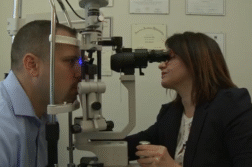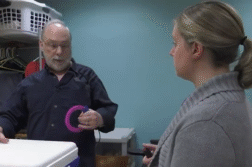CLEVELAND, Ohio. (Ivanhoe Newswire) – 3D printing, it’s moved out of the engineering lab and into the hands of doctors. In fact, now doctors are using it to create exact replicas of a patient’s anatomy, helping surgeons to navigate through difficult operations before even entering the OR.
Daniel Rayes was living his dream managing an upscale diner.
“I get to serve them, take care of them, talk to them and then form relationships,” Rayes described.
A happy, healthy 25-year-old until …
“I started to get like delirious and dizzy. It felt like I had a migraine, but like there was a spoon digging outward, it was above my right temple and behind my ear,” Rayes told Ivanhoe.
Rayes had a brain aneurysm, a weakening of a blood vessel. If not treated, it can cause stroke or even death. Angiograms and CAT scans give surgeons a detailed look at the problem before surgery.
“Planning is the biggest thing; it’s sort of like building a house. You don’t have blueprints. It’s really hard to be successful,” Mark Bain, MD, Neurosurgeon at Cleveland Clinic, explained.
Now, neurosurgeons are using information from the scans to make exact 3D printed replicas, the same size and same shape of the aneurysms.
“When you can actually print an aneurysm and hold it in your hand in life size and be able to rotate it and see it, it really means everything. I mean, you can plan the whole procedure,” Bain described.
Surgeons can develop a patient-specific plan, visualizing the surgical approach, cutting time in the operating room by almost half, and it’s an educational tool for patients and young doctors. As for Rayes, his surgeons were able to clearly see his aneurysm. They clipped it to prevent it from bleeding and now he’s back at the diner.
“I have friends here. I have customers and coworkers that care about me and I care about them,” Rayes said.
Serving up some sweet times for everyone.
The cost of 3D printing is one limiting factor, as is time. Because it typically takes a couple of weeks to generate a replica, the technology is limited to non-urgent, non-ruptured aneurysms.
Contributors to this news report include: Marsha Lewis, Producer; Kirk Manson, Videographer; Matt Goldschmidt, Editor.
To receive a free weekly e-mail on Medical Breakthroughs from Ivanhoe, sign up at: http://www.ivanhoe.com/ftk
MEDICAL BREAKTHROUGHS
RESEARCH SUMMARY
TOPIC: FIXING BRAINS: CREATING ANEURYSMS IN 3D
REPORT: MB #4711
BACKGROUND: Aneurysms are an enlargement of an artery. The main cause is weakness in the arterial wall.. There are 30,000 that occur each year and nearly 40 percent of these are fatal within 24 hours. There are different types: aortic, cerebral and peripheral. Aortic aneurysms are between 2-3 centimeters in diameter, but they can expand beyond 5 cm. They lead to 25,000 deaths a year. The most common aortic aneurysm is an abdominal aortic aneurysm which has a survival rate of 20 percent without treatment, when the diameter is over 6 cm. The other type, which is rare, is a thoracic aortic aneurysm which has a 56 percent survival rate without surgery, and it jumps to 85 percent after surgery. Forty percent of cerebral aneurysms are fatal.
(Source: https://www.medicalnewstoday.com/articles/156993#types
TREATMENT: There are two surgical options for patients. The first is surgical clipping which is used to close off the aneurysm. The other procedure is a less invasive procedure called endovascular coiling. This involves putting a catheter into the artery through the groin and then to the aneurysm. There are large risks such as bleeding in the brain or blood flow loss to the brain. If the aneurysm is ruptured, interventions to prevent stroke through injecting vasopressor and rehabilitative therapy. For unruptured brain aneurysms, the surgical procedures can prevent a future rupture. Some of the factors that go into deciding upon treatment are based on the size and location of the aneurysm, age, family history of ruptured aneurysms and congenital conditions.
(Source: https://www.mayoclinic.org/diseases-conditions/brain-aneurysm/diagnosis-treatment/drc-20361595
NEW TECHNOLOGY: There is a new procedure for patients to use called flow diversion. The flow diversion is an endovascular technique that places a device in the parent blood vessel to divert blood flow away from the aneurysm. The name of the device is the Pipeline Embolization Device which is deployed across the neck of the aneurysm. Another piece of technology that is helping doctors is 3D printing. Dr. Bain said the first time he tried the procedure the 3D printer showed a branch that was not appreciated on the scan. This helped doctors cut the procedure time in half.
(Source: Mark Bain, MD https://www.hopkinsmedicine.org/neurology_neurosurgery/centers_clinics/aneurysm/treatment/flow-diversion.html
FOR MORE INFORMATION ON THIS REPORT, PLEASE CONTACT:
Andrea Pacetti
PACETTA@ccf.org
If this story or any other Ivanhoe story has impacted your life or prompted you or someone you know to seek or change treatments, please let us know by contacting Marjorie Bekaert Thomas at mthomas@ivanhoe.com



